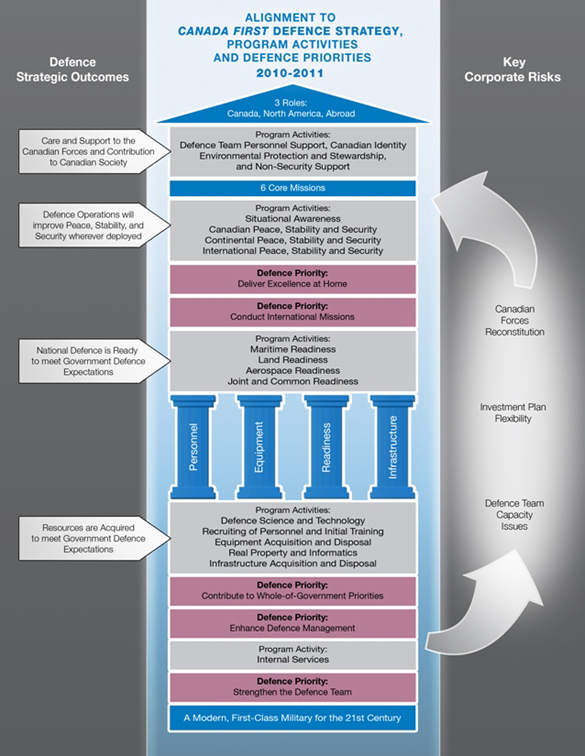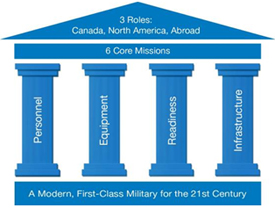Common menu bar links
Breadcrumb Trail
ARCHIVED - National Defence - Report
 This page has been archived.
This page has been archived.
Archived Content
Information identified as archived on the Web is for reference, research or recordkeeping purposes. It has not been altered or updated after the date of archiving. Web pages that are archived on the Web are not subject to the Government of Canada Web Standards. As per the Communications Policy of the Government of Canada, you can request alternate formats on the "Contact Us" page.
MINISTER'S MESSAGE
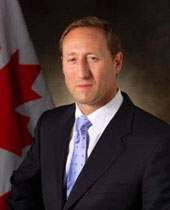 I am proud to present the 2010-11 Departmental Performance Report for the Department of National Defence and the Canadian Forces (DND/CF)1.
I am proud to present the 2010-11 Departmental Performance Report for the Department of National Defence and the Canadian Forces (DND/CF)1.
Defending Canada and Canadians is the top priority of National Defence and the Canadian Forces. In 2010-11, the CF continued to monitor Canada's air and maritime approaches, conducted domestic operations across the country, and demonstrated Canada's Arctic sovereignty through activities such as Operation NANOOK. We supported civil authorities in securing the G8 leaders' summit in Huntsville and the G20 summit in Toronto, helped respond to the effects of Hurricane Igor in Newfoundland and Labrador, and aided stranded motorists in Southern Ontario when a massive snowstorm affected that region in December 2010.
National Defence worked closely with the United States, our closest ally and defence partner, in the defence of North America. For example, we cooperated with the United States through North American Aerospace Defence Command (NORAD), conducted common exercises and training to ensure the continuing interoperability of our militaries, and engaged in high-level meetings and staff talks that enabled us to explore potential new areas of cooperation. We are also partners with the US in counter-narcotics operations in the Caribbean and East Pacific through the Joint Inter-Agency Task Force - South. Under Operation CARIBBE, CF warships deployed to the region, helping to meet the security challenges of the world's longest coastline.
The CF made a tremendous contribution to international security. We continued our historic role as part of the International Security Assistance Force (ISAF) in Afghanistan, helping Afghans rebuild their country as a stable, democratic and self-sufficient society that is no longer a safe haven for terrorists. We also began preparing for our new non-combat training mission that will build on Canadian Forces experience in training Afghan National Security Forces, thereby preparing Afghans to assume responsibility for their own security and sovereignty.
While preparing for the mission transition in Afghanistan, we remained ready to deploy elsewhere around the world if requested to do so by the Government of Canada. Our high level of readiness was demonstrated through the participation and leadership of the CF in the multinational response to the crisis in Libya, including evacuation operations and the protection of civilians.
Over the past year, thirteen CF members lost their lives in the line of duty in Afghanistan, with a total of 157 over the course of the combat mission, while many other men and women in uniform were injured. National Defence recognizes the enormous sacrifices made by our armed forces and has continued to improve the care offered to injured and ill CF personnel, our veterans and their families. At the same time, we have continued to recruit and train Canada's brightest individuals into the CF and the department's civilian workforce.
While modernizing the CF and its capabilities, National Defence has emphasized the responsible management of resources. In line with Government priorities, we have continued to seek new ways to maximize the effectiveness of every dollar invested in the four Canada First Defence Strategy (CFDS) pillars of personnel, equipment, readiness and infrastructure. Our investments have generated economic activity and jobs in Canadian communities.
Canadians are proud of the work done by the CF and the Department of National Defence, from helping those in need at home to projecting our values and advancing our interests abroad. It is an honour to serve as Minister of National Defence and present the achievements of this great national institution to Parliament and Canadians.
Original signed by:
The Honourable Peter MacKay, P.C., M.P.
Minister of National Defence
Section I: DEPARTMENTAL OVERVIEW
Introduction
The Defence Team Mission is to provide combat-capable, multi-purpose forces for employment both at home and abroad to protect Canada and Canadians, and to deliver strategic effect for Canada. To accomplish this, Defence must be agile, flexible, affordable and resilient. We recruit, generate, employ and sustain world-class forces that work cohesively to advance Canadian interests and to maintain our reputation as a trusted and relevant partner at home and abroad.
Defence must be sustainable while serving the national interest. Our core responsibility is to succeed in operations while providing an affordable program of activities, preparing for future operational challenges and caring for our military members and their families.
The following recurring themes and challenges are highlighted within the report and outline the focus of our activities for the 2010-11 reporting period:
- Caring for our people;
- Implementing the Canada First Defence Strategy and ensuring success in domestic, continental and international operations; and
- Contributing to the security and economic prosperity of Canadian society.
The ever-evolving global security environment continues to occupy the international agenda. Challenges include global terrorism, varying degrees of involvement in regional conflicts around the world, insurgencies, weapons proliferation (both of mass destruction and conventional), piracy, and, increasingly, cyber attacks. While all of this is within the context of global financial uncertainty, the Defence Team continues to adapt, and continues to be prepared to meet these challenges.
Raison d'�tre and Responsibilities
The National Defence Act2 establishes the Department of National Defence (DND) and the Canadian Forces (CF) as separate entities, operating with an integrated National Defence Headquarters, as they pursue their primary responsibility of providing defence for Canada and Canadians.
On behalf of the people of Canada, Defence stands ready to perform three key roles:
- Defend Canada - by delivering excellence at home;
- Defend North America - by being a strong and reliable partner with the United States in the defence of the continent; and
- Contribute to International Peace and Security - by projecting leadership abroad.
The Defence mandate is carried out with the support of a group of related organizations and agencies within the portfolio of the Minister of National Defence. For further details on selected Defence Portfolio organizations, please refer to Section IV: Other Items of Interest - Selected Defence Portfolio HR and Financial Resources. For further information on the legislative framework within which Defence operates, please see Section IV: Other Items of Interest - Legislative Environment.
The Departmental Performance Report (DPR) for Fiscal Year (FY) 2010-11 is based upon the following foundational elements:
- The Defence Program Activity Architecture (PAA), which defines strategic outcomes and program activity areas and provides the planning, management and reporting structure for Defence;
- The Canada First Defence Strategy (CFDS), which mandates specific core missions and capability investments;
- The Defence Priorities for FY 2010-11, which identify specific commitment areas within Defence to which additional effort and resources were allocated to mitigate risks and thus enable the delivery of the Defence mandate; and
- The Corporate Risk Profile (CRP), which documents the key risks impacting Defence activities and their associated mitigation strategies.
Strategic Outcomes and Program Activity Architecture
Within Treasury Board Secretariat's Policy on Management, Resources and Results Structures3 (MRRS) for planning, management and reporting, the Program Activity Architecture (PAA)4 sets out the strategic outcomes that reflect the Department's mandate and vision. While the PAA inventories activities undertaken by the Department, the strategic outcomes indicate the planned benefits arising from these activities.
Defence's four strategic outcomes, each supported by related program activities, are:
- Defence Operations will improve Peace, Stability and Security wherever deployed;
- National Defence is Ready to meet Government Defence Expectations;
- Resources are Acquired to meet Government Defence Expectations; and
- Care and Support to the Canadian Forces and Contribution to Canadian Society.
Each Defence Strategic Outcome and Program Activity has aligned to it relevant Defence Priorities and Corporate Risks, and is aligned to a Government of Canada Outcome Area. For further information, please refer to Strategic Outcomes in the Performance Summary area of this section.
For a full illustration of the Defence PAA, please refer to Section IV: Other Items of Interest - Defence Program Activity Architecture. For descriptions of Defence strategic outcomes and associated program activities, please refer to Section II: Analysis of Program Activities by Strategic Outcome.
Risk Analysis
A core facet of Defence planning and conduct of operations is the identification and mitigation of risk. The extensive involvement in Afghanistan and other foreign missions, along with the substantial domestic commitments in the Arctic, continued to test the Department's capacity. Defence's exemplary achievement of these tasks underscored the Department's flexibility and determination to succeed in the face of limited operational resources.
Considerable effort has been expended to develop and document the plans and measures to mitigate the key challenges that impact Defence's ability to meet its mission. The following three areas of risk, which were also highlighted in the 2010-11 Defence Priorities, reflect the critical areas of focus for Defence during 2010-11:
| Key Corporate Risks | |
|---|---|
| Risk | Action |
| Defence Team Capacity | Priority is being placed on achieving the right balance and composition of the Defence workforce, with a strong focus on ensuring the framework is in place to effectively manage personnel |
| Canadian Forces Reconstitution | Plans for the transition of our mission in Afghanistan, including the redeployment and reconstitution of resources, are being developed, along with the determination of the CF readiness posture post-2011 |
| Investment Plan Flexibility | Efforts continue to ensure that there is sufficient flexibility to respond to emerging requirements in a timely fashion and to manage changes to costs over time |
To support the accomplishment of its mandate, Defence continued to develop and implement a strong risk management framework that is being integrated into the departmental resource planning and business management processes. Coupled with performance measurement, the concepts of risk and opportunity are being embedded as key inputs to senior leadership decision-making.
Performance Summary
In FY 2010-11, the CF successfully conducted a range of missions at home and abroad in the defence of Canada and Canadians, in collaboration with our whole-of-government and international partners. Defence helped keep Canadians safe at home by assisting domestic law enforcement agencies in securing major international events and dealing with illegal migration on the west coast. The CF lent a helping hand to Canadians in need when the Government of Newfoundland and Labrador requested assistance in dealing with the aftermath of Hurricane Igor. Defence also continued to support multinational drug interdiction operations in the Caribbean and East Pacific, helping disrupt the flow of illicit drugs to Canadian communities.
The CF made a significant contribution to international security. We continued to participate in the International Security Assistance Force (ISAF) in Afghanistan, where the CF conducted counter-insurgency operations in Kandahar province while at the same time preparing for its new role of training the Afghan National Army (ANA) and Afghan National Police (ANP). Our close cooperation with US forces and other domestic and international partners increased security and enabled governance and development to move forward, particularly in the Panjwai and Dand districts of Kandahar. The CF also demonstrated a high level of readiness to deploy elsewhere around the world if requested to do so by the Government of Canada, as evidenced by our participation in the NATO-led Operation MOBILE in Libya. This operation included evacuation efforts and participation in the multinational response to the crisis in Libya, aimed at the protection of civilians through the establishment of a No Fly Zone and an arms embargo.
Defence also continued the modernization of the CF by advancing numerous key projects while seeking new efficiencies. In FY 2010-11, Defence invested $2.5 Billion in capital acquisitions to obtain or renew core CF combat capabilities and equipment platforms, including the acquisition of Hercules C130-J aircraft and Leopard 2 tank chassis, as well as the advancement of the HALIFAX class frigate modernization. At the same time, new efficiencies such as defence information technology (IT) modernization helped ensure that departmental resources remained focused on the key priorities that enable CFDS. Through these and other activities, Defence has continued to meet the defence expectations of the Government of Canada and Canadians.
| Financial Resources ($ thousands) |
|||
|---|---|---|---|
| Planned Spending | Total Authorities | Actual Spending | |
| Capital Spending (included in Departmental Spending) |
5,499,442 | 5,311,275 | 3,807,286 |
| Departmental Spending | 21,827,387 | 22,754,618 | 20,298,257 |
| Human Resources Summary (Full-Time Equivalent - FTE)5 | |||
|---|---|---|---|
| Planned | Actual | Difference | |
| Regular Force | 67,742 | 68,251 | 509 |
| Primary Reserve (Class C) | 1,600 | 967 | (633) |
| Total Military | 69,342 | 69,218 | (124) |
| Total Civilian | 30,355 | 28,558 | (1,797) |
| TOTAL | 99,697 | 97,776 | (1,921) |
Notes:
- Class A and B Reserve Force FTE numbers are calculated using a different methodology, and are not included in this table. Further information on Primary Reserve Expenditures can be found in Section IV: Other Items of Interest - Reserve.
- Civilian figures include Communications Security Establishment Canada, National Search and Rescue Secretariat, and the Office of the Ombudsman.
|
Strategic Outcome: |
|||||||||
|---|---|---|---|---|---|---|---|---|---|
| Performance Indicators | Targets | 2010-11 Performance6 | |||||||
| Performance against CFDS as measured by Investment Plan and Business Plans | 100% | Somewhat Met: Actual 60% | |||||||
| Program Activity | ($ thousands) | Alignment to Government of Canada Outcomes | |||||||
| 2009-10 Actual Spending | 2010-11 | ||||||||
| Main Estimates | Planned Spending | Total Authorities | Actual Spending | ||||||
| Defence Science and Technology | CS | 17,710 | 40,528 | 40,528 | 31,615 | 32,996 | An innovative and knowledge-based economy | ||
| DS | 367,015 | 368,370 | 369,004 | 371,965 | 384,947 | ||||
| Recruiting of Personnel and Initial Training | CS | 2,473 | 9,338 | 9,338 | 9,338 | 4,871 | A safe and secure world through international cooperation | ||
| DS | 1,205,863 | 604,741 | 604,909 | 662,437 | 1,117,863 | ||||
| Equipment Acquisition and Disposal | CS | 2,353,544 | 3,099,303 | 3,415,763 | 3,232,044 | 2,528,130 | A safe and secure world through international cooperation | ||
| DS | 2,639,404 | 3,239,677 | 3,556,832 | 3,382,768 | 2,779,775 | ||||
| Real Property and Informatics Infrastructure Acquisition and Disposal | CS | 347,572 | 580,051 | 877,460 | 796,986 | 371,264 | Strong economic growth | ||
| DS | 385,299 | 651,440 | 948,962 | 859,598 | 414,945 | ||||
| Total Spending | CS | 2,721,299 | 3,729,220 | 4,343,089 | 4,069,984 | 2,937,261 | |||
| DS | 4,597,581 | 4,864,228 | 5,479,708 | 5,276,769 | 4,697,531 | ||||
DS: Departmental Spending; CS: Capital Spending (included in Departmental Spending) | Due to rounding, figures may not add up to totals shown.
| Strategic Outcome: National Defence is Ready to meet Government Defence Expectations |
|||||||||
|---|---|---|---|---|---|---|---|---|---|
| Performance Indicators | Targets | 2010-11 Performance | |||||||
| % Readiness level for Maritime, Land and Aerospace combined | 100% | Mostly Met: Actual 99.6% | |||||||
| Program Activity | ($ thousands) | Alignment to Government of Canada Outcomes | |||||||
| 2009-10 Actual Spending | 2010-11 | ||||||||
| Main Estimates | Planned Spending | Total Authorities | Actual Spending | ||||||
| Maritime Readiness | CS | 27,323 | 35,104 | 35,104 | 35,104 | 45,506 | A safe and secure world through international cooperation | ||
| DS | 2,088,812 | 1,975,937 | 1,977,912 | 2,045,146 | 2,164,323 | ||||
| Land Readiness | CS | 31,323 | 114,474 | 114,474 | 114,474 | 65,054 | A safe and secure world through international cooperation | ||
| DS | 3,364,302 | 4,047,080 | 4,049,320 | 4,202,136 | 3,350,735 | ||||
| Aerospace Readiness | CS | 28,488 | 24,796 | 24,796 | 88,047 | 39,844 | A safe and secure world through international cooperation | ||
| DS | 1,780,296 | 2,269,753 | 2,270,696 | 2,418,089 | 1,781,696 | ||||
| Joint and Common Readiness | CS | 100,443 | 170,407 | 191,113 | 202,444 | 128,520 | A safe and secure world through international cooperation | ||
| DS | 2,057,936 | 2,181,823 | 2,204,212 | 2,342,339 | 2,187,920 | ||||
| Total Spending | CS | 187,577 | 344,781 | 365,488 | 440,069 | 278,924 | |||
| DS | 9,291,345 | 10,474,593 | 10,502,139 | 11,007,710 | 9,484,674 | ||||
DS: Departmental Spending; CS: Capital Spending (included in Departmental Spending) | Due to rounding, figures may not add up to totals shown.
| Strategic Outcome: Defence Operations will Improve Peace, Stability and Security Wherever Deployed |
|||||||||
|---|---|---|---|---|---|---|---|---|---|
| Performance Indicators | Targets | 2010-11 Performance | |||||||
| % Effects Achieved (aggregate for all commands) | 100% of intended effects achieved | Mostly Met: Actual 93.3% | |||||||
| Program Activity | ($ thousands) | Alignment to Government of Canada Outcomes | |||||||
| 2009-10 Actual Spending | 2010-11 | ||||||||
| Main Estimates | Planned Spending | Total Authorities | Actual Spending | ||||||
| Situational Awareness | CS | 89,022 | 136,164 | 136,164 | 154,348 | 192,657 | A safe and secure world through international cooperation | ||
| DS | 667,671 | 664,479 | 665,323 | 695,470 | 775,516 | ||||
| Canadian Peace, Stability and Security | CS | 13,626 | 5,757 | 5,957 | 6,431 | 1,908 | A safe and secure Canada | ||
| DS | 506,058 | 324,514 | 383,055 | 408,705 | 318,492 | ||||
| Continental Peace, Stability and Security | CS | 2,726 | 5,352 | 5,352 | 5,352 | 966 | A strong and mutually beneficial North American partnership | ||
| DS | 193,523 | 198,434 | 201,963 | 199,047 | 190,987 | ||||
| International Peace, Stability and Security | CS | 270,369 | 543,334 | 553,429 | 541,121 | 225,196 | A safe and secure world through international cooperation | ||
| DS | 2,109,578 | 2,352,720 | 2,360,997 | 2,753,496 | 2,312,846 | ||||
| Total Spending | CS | 375,743 | 690,607 | 700,902 | 707,252 | 420,727 | |||
| DS | 3,476,830 | 3,540,147 | 3,611,337 | 4,056,717 | 3,597,840 | ||||
DS: Departmental Spending; CS: Capital Spending (included in Departmental Spending) | Due to rounding, figures may not add up to totals shown.
| Strategic Outcome: Care and Support to the Canadian Forces and Contribution to Canadian Society |
|||||||||
|---|---|---|---|---|---|---|---|---|---|
| Performance Indicators | Targets | 2010-11 Performance | |||||||
| % of Public Support for the Canadian Forces | 85-100% | Met all: Actual 87% | |||||||
| Program Activity | ($ thousands) | Alignment to Government of Canada Outcomes | |||||||
| 2009-10 Actual Spending | 2010-11 | ||||||||
| Main Estimates | Planned Spending | Total Authorities | Actual Spending | ||||||
| Defence Team Personnel Support | CS | 18,057 | 15,580 | 15,580 | 15,580 | 28,327 | A safe and secure world through international cooperation | ||
| DS | 938,805 | 636,050 | 643,219 | 672,726 | 906,016 | ||||
| Canadian Identity | CS | 12,748 | 9,599 | 9,599 | 11,099 | 11,512 | A vibrant Canadian culture and heritage | ||
| DS | 348,329 | 346,922 | 346,994 | 350,312 | 353,602 | ||||
| Environment Protection and Stewardship | CS | 966 | 841 | 841 | 3,347 | 1,585 | A clean and healthy environment | ||
| DS | 140,235 | 153,234 | 152,763 | 152,458 | 122,478 | ||||
| Non-Security Support | CS | 89 | 78 | 78 | 78 | 55 | A transparent, accountable and responsive federal government | ||
| DS | 7,474 | 22,179 | 22,191 | 22,189 | 6,479 | ||||
| Total Spending | CS | 31,860 | 26,098 | 26,098 | 30,104 | 41,478 | |||
| DS | 1,434,843 | 1,158,385 | 1,165,167 | 1,197,684 | 1,388,575 | ||||
DS: Departmental Spending; CS: Capital Spending (included in Departmental Spending) | Due to rounding, figures may not add up to totals shown.
| Internal Services | ||||||
|---|---|---|---|---|---|---|
| Program Activity | ($ thousands) | |||||
| 2009-10 Actual Spending |
2010-11 | |||||
| Main Estimates | Planned Spending | Total Authorities | Actual Spending | |||
| Total Spending | CS | 26,954 | 63,865 | 63,865 | 63,865 | 128,897 |
| DS | 1,055,071 | 1,064,160 | 1,069,036 | 1,215,738 | 1,129,637 | |
DS: Departmental Spending; CS: Capital Spending (included in Departmental Spending) | Due to rounding, figures may not add up to totals shown.
Expenditure Profile
| Departmental Spending ($ thousands) | |||||
|---|---|---|---|---|---|
| 2008-09 | 2009-10 | 2010-11 | |||
| Actual Spending | Actual Spending | Main Estimates | Planned Spending | Total Authorities | Actual Spending |
| 19,184,852 | 19,855,670 | 21,101,513 | 21,827,387 | 22,754,618 | 20,298,257 |
In FY 2010-11, the Main Estimates were increased through Supplementary Estimates and allotments from Treasury Board by $1,653.1 Million. The differences between total authorities and actual spending of $2,456.3 Million results primarily from: $1,002.3 Million in delays in capital projects, portions of which will be re-profiled to future years in accordance with specific projects' cash flow schedules; $443.5 Million in operating budget carry forward that will be available to Defence in FY 2011-12; $49.3 Million in identified lapses related to security at the G8/20 summits and 2010 Olympics that was not required by the Department; and $950.4 Million in residual lapses. Within the context of capacity challenges to deliver the CFDS program, the $950.4 Million residual lapse, which represents 4.2 per cent of total spending authorities, resulted largely from $490 Million in delays to capital and infrastructure projects. Examples include: Maritime Helicopter Project at $294 Million due to foreign exchange rate fluctuations and project delays; Light Howitzer Project at $106 Million related to vehicle acquisition delays; Unmanned Aerial Vehicle System Project at $35 Million due to changes in operational requirements for the system; and Armoured Personnel Carrier at $53.7 Million due to project delays. In addition, the capital equipment in-service support program realized a spending shortfall of $351 Million owing largely to slippages to scheduled Repair and Overhaul activities, long delivery lead times, changes in Foreign Military Sales payment schedules, changes to the scope of requirements, delays in staffing procurement requirements, time variance in negotiating and awarding contracts and, importantly, capacity challenges for Defence, PWGSC and industry to execute in-service support requirements. Specific examples include general navy sparing at $20 Million; contractor furnished materials for the submarine program at $10M; ammunition for deployed operations at $18 Million; Chinook Helicopter support at $13 Million owing to Foreign Military Sales and Cooperative Logistics delivery delays; Leopard Tank support at $12 Million owing to decreased tank operations in theatre; Land Command Support System at $9.5 Million due to decreased activity levels; and delays in the delivery of spare parts (Wheeled Light Armoured Vehicle at $5 Million, Small Arms at $3.5 Million, Initial Cadre Training at $1.7 Million, Life support equipment spares at $1.5M, Operational Clothing at $1 Million; and CF 188 at $2.5 Million).
The total spending difference of $442.6 Million between fiscal years 2009-10 and 2010-11 is attributed mainly to an increase of $146.8 Million for military and civilian pay and allowances; $125.3 Million for professional and other services; $286.8 Million increase for construction and acquisition of land and equipment; and a $112.2 Million net increase across other categories of departmental expenditures, which are offset mainly in the following categories: $107.5 Million decrease in travel, transportation and telecom expenditures; a decrease of $64.2 Million in rental of buildings and equipment; and a $56.8 Million decrease in repairs of equipment.
Departmental Spending for Fiscal Year 2010-11 by Program Activity
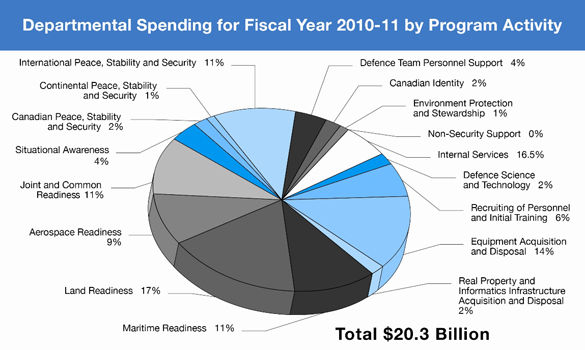
Financial Spending Trend
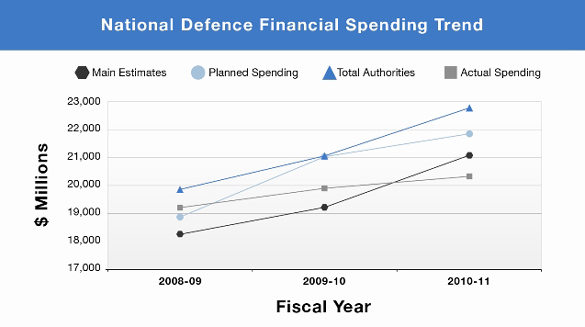
Notes:
- The "Main Estimates" figure is submitted in December, prior to the start of a new fiscal year. It includes the known approved level of funding for the department as of October.
- "Planned Spending" provides an update of the Main Estimates information on additional funding approved between October and February, as well as expected funding to be approved in the new fiscal year for which Treasury Board Secretariat has approved disclosure.
- "Total Authorities" represent the final authority as shown in the Public Accounts. This figure represents the final level of approved funding.
- "Actual Spending", also found in the Public Accounts, represents the final spending on a cash basis.
Estimates by Vote
For information on our organizational votes and/or statutory expenditures, please see the 2010-11 Public Accounts of Canada (Volume II) publication. An electronic version of the Public Accounts is available at http://www.tpsgc-pwgsc.gc.ca/recgen/txt/72-eng.html.
The Canada First Defence Strategy
To help Defence carry out our roles and responsibilities, the Canada First Defence Strategy7 (CFDS), released in May 2008, outlines what is required to ensure a first-class, modern military that is well-trained, well-equipped and ready to take on the challenges of the 21st century.
To accomplish this, the CFDS provides a 20-year roadmap to modernize the CF with stable and predictable funding that permits long-term planning and investment in four Defence capability areas or pillars:
- Personnel: Expand the CF to a total strength of 100,000 (Regular 70,000/Reserve 30,000) by FY 2027-28;
- Equipment: Renew the CF's core equipment platforms;
- Readiness: Maximize personnel training and equipment availability; and
- Infrastructure: to meet Canada's future defence and security requirements, the Government of Canada intends to replace or refurbish approximately 25 per cent of DND infrastructure holdings within 10 years, with approximately 50 per cent being replaced or refurbished over 20 years.
The CFDS articulates the strategic vision for Defence aligned with the Government of Canada's level of ambition. It outlines six core CF missions in domestic, continental and international contexts:
- Conduct daily domestic and continental operations, including in the Arctic and through North American Aerospace Defense Command (NORAD);
- Support a major international event in Canada such as the G8, G20 and North American Leaders' Summits;
- Respond to a major terrorist attack;
- Support civilian authorities during a crisis in Canada such as a natural disaster;
- Lead and/or conduct a major international operation for an extended period; and
- Deploy forces in response to crises elsewhere in the world for shorter periods.
The Defence Priorities
The Defence Priorities are informed by key corporate risks and represent a focused number of areas where efforts and resources will be directed to mitigate those risk areas and in so doing, address gaps in capability or capacity to enable Defence to effectively carry-out Government direction. To respond to the Government‘s priorities for Defence and support the activities essential to achieve excellence in our operations and management, the Defence Priorities articulated in Report on Plans and Priorities (RPP) 2010-11 were to:
- Deliver Excellence at Home;
- Conduct International Missions;
- Contribute to Whole-of-Government Priorities;
- Strengthen the Defence Team; and
- Enhance Defence Management
Table: Contribution of Defence Priorities to PAA Strategic Outcome(s) and Government of Canada Priorities
This table illustrates the Priorities for Defence which supported Government of Canada Priorities during the reporting period. The description provides the rationale and outlines the activities for each Defence priority. Performance information, as detailed in Section II of this report, effectively measures the progress of each activity and facilitates a meaningful assessment of how well they have contributed to the achievement of Defence's Strategic Outcomes.
| Defence Priority |
Type | Links to Strategic Outcome(s) | Description | |||||
|---|---|---|---|---|---|---|---|---|
| Acquire resources to meet Government's Defence expectations |
The CF are ready to meet Government's Defence expectations |
Increase Peace, Stability and Security | Care for CF and Contribution to Canadian Society |
Internal Services | ||||
| Deliver Excellence at Home |
O | S | P |
CFDS - Maintaining ability to conduct six core missions within Canada, in North America and globally, at times simultaneously
|
||||
| Conduct International Missions | O | S | P |
CFDS - Maintaining ability to conduct six core missions within Canada, in North America and globally, at times simultaneously
|
||||
| Contribute To Whole-Of-Government Priorities |
O | P | S |
CFDS - Building on the Government's investments in the military
|
||||
| Strengthen The Defence Team | O | P | S |
Public Service Renewal - Planning, recruitment, employee-development, and enabling infrastructure
CFDS - Investing in people
|
||||
| Enhance Defence Management | O | S | p |
CFDS - Strengthening key military capabilities through focused investment in each of the pillars
|
||||
| Legend: N = New O = Ongoing | P = Primary S = Secondary | |||||||
Defence Planning and Performance Reporting Framework
The following diagram illustrates the alignment of Defence's PAA, Risks and Priorities to the CFDS for FY 2010-11. This framework forms the basis for communicating Defence's performance story throughout this report.
